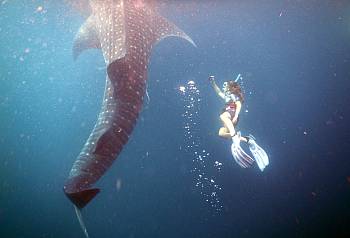
Rachel swims with a 15m whale shark
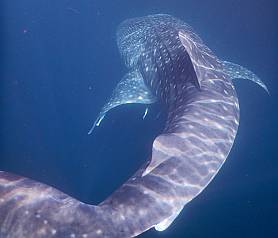
Sinuous, long, graceful and docile
|
Underwater Pages Reef Animals |
Sharks & Rays
Larger fish (usually on the outer reef) include sharks (with their often attached sharksuckers), manta rays, barracuda, and pelagic fish such as tunas and rainbow runners. Getting pictures is tricky with our small camera and the strobe which has a limited distance. We are often more than 10 meters (33 feet) down when we encounter these larger fish, and so the light is very blue. The dots you see on some of the shots are called "backscatter" and result from particles in the water reflecting the light from the flash back at the camera. The rays we encounter are often in shallower water either near the boat or where we snorkel.
 Rachel swims with a 15m whale shark |
 Sinuous, long, graceful and docile |
Graceful, docile and amazing to see and swim with, are the world's largest fish: Whale Sharks Rhincodon typus. These sharks can attain a length of up to 60ft (158m) and they are filter feeders preferring plankton, though some do eat small bait fish. They are completely harmless to humans, but they should not be touched or harassed. Some whale sharks are migratory, but other populations appear to stay in certain locales, such as those in Cenderwasih Bay in eastern Indonesia. Although it's hard to determine longevity, it is believed that whale sharks live to be between 70 and 100 years old. Born live at about 22in (10cm), they don't reach maturity until almost 30 years. We had the thrill of snorkeling with whale sharks on many occasions in Triton Bay, Indonesia, where the sharks come each day to feed on the fish that drop from the nets of stationary fishing platforms (called "bagans"). The fishermen who work the bagans are happy to have us swim around their platform with these giant fish. Whale sharks are easily identifiable by their gray under-color and white spots which, together with their size, makes them unmistakable. They are listed Endangered on the CITES list.

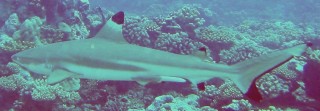 Blacktip Reef Sharks Carcharhinus melanopterus are the
most common sharks encountered in the waters of French Polynesia.
They may be inside or outside lagoons, and although the book says they
are rarely found below 65 feet (20m), Jon did a dive in the
Tuamotus and reported that the canyons at 90 feet were filled
with blacktips. They are not considered dangerous, and we got
quite used to swimming with them. In the Tuamotus, they were
ubiquitous, but sometimes not visible until we threw biodegradable
garbage over the side. Then they and many larger reef fish
would swarm our boat. With their light brownish-gray back and
lighter undersides, they look soft (which they're not) and almost
puppy-like in their enthusiasm to investigate the goings on around
the boats.
Blacktip Reef Sharks Carcharhinus melanopterus are the
most common sharks encountered in the waters of French Polynesia.
They may be inside or outside lagoons, and although the book says they
are rarely found below 65 feet (20m), Jon did a dive in the
Tuamotus and reported that the canyons at 90 feet were filled
with blacktips. They are not considered dangerous, and we got
quite used to swimming with them. In the Tuamotus, they were
ubiquitous, but sometimes not visible until we threw biodegradable
garbage over the side. Then they and many larger reef fish
would swarm our boat. With their light brownish-gray back and
lighter undersides, they look soft (which they're not) and almost
puppy-like in their enthusiasm to investigate the goings on around
the boats.
In much of the western Pacific, and Indonesia, sharks are still caught and killed for their fins for the shark fin soup market in China. Although now illegal, many people in the smaller villages and islands of eastern Indonesia do not respect the need to preserve this reef predator for the sake of preserving the reef ecosystem as a whole. Sadly, in hundreds of hours of diving and snorkeling we saw only a handful of reef sharks in Raja Ampat or Triton Bay, areas of the highest bio-diversity off Indonesia. Education is sorely needed if the slaughter is to stop. (photo: Moorea, Fr. Polynesia)
 Lying docilely under ledges and rocks, the bizarre Tasseled Wobbegong Shark Eucrossorhinus dasypogon looks deceptively harmless. It is, in fact, a night predator and can move rapidly from its resting place to attack prey that venture too close. Divers who step on a wobbegong tail or fin have been bitten. There are several species of wobbegongs, many of which inhabit the reefs of southern and eastern Australia. The first ones we ever saw were the Tasseled Wobbegongs in the dive sites of Triton Bay in eastern Indonesia. The tassel-like fringe around the front of the wobbegong's head is made up of flaps of skin. (The divers' underwater sign for "wobbegong shark" is the traditional hand on top of the head -- like shark dorsal fin -- and then fingers wiggling from the chin, like the skin flaps.) Wobbies (as they are called in Australia) have intricate patterns of tan and white on their backs and pectoral fins and tails. The head is flattened and the the tail if often curled inward making it hard to judge the actual length of the shark. Most day-time sightings of wobbies are under ledges or nestled between bommies on the sea floor. (Triton Bay. Photo by S Hacking) |
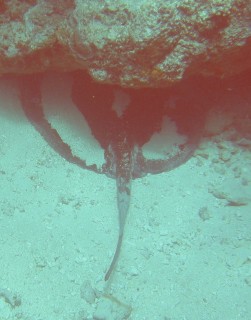 |
Rays are relatively shy creatures, often burying in sand, or in the case of this Thorny Stingray Urgymnus asperrimus, resting half under a coral shelf in shallow water. With a disc of about one meter, this pale gray to brown stingray has a tail of about similar length. Its back is covered by many "thorns" and the disc is humped in the middle. (New Caledonia) |
| Most of the spotted eagle rays that we've seen have been between 4 and 6 feet (about 1-2m) wingtip to wingtip, although some references suggest they can get over 11 ft (3m). Unlike many other rays the Spotted Eagle Ray Aetobatus narinari has a very triangular disc, more like wings, with a protruding head. They're black to gray-brown with many white spots on the back, and a white underside. Their long tail has only a single spine. Spotted eagle rays are found in all tropical and warm temperate seas around the world, and we saw them first in the Caribbean, idly swimming around a rocky outcropping. At anchor in the Galapagos we saw a fleet of 10 or 12 cruising over a clear sandy bottom. (Galapagos Islands) |
 |
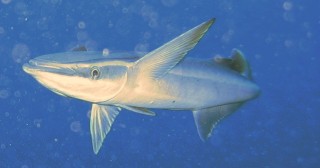 Shark-suckers tried to attach to us in Moorea |
The shark-sucker Echeneis naucrates (not related to sharks, but living in close community with them) is a species of remora. They grow to over 3 feet (1 meter), and are pale gray to nearly black with a white line. The ones we most commonly saw were pale gray to almost white. They attach themselves to sharks, mantas, sea turtles, or large fish via a suction disk on the top of their flat heads. They are then in a prime position to feed on the scraps from the bigger fish feeding. In the Tuamotus, one attached itself to the keel of Ocelot for a week, riding with us from one anchorage to the next, a distance of over 20 miles within one lagoon. Old sailors used to believe that they were bad luck, and could slow even a big ship down to a crawl. They can also be pesky to divers, trying to attach to legs, torso, or tanks. To disengage them, you have to push them forward. (photo: Moorea, Fr. Polynesia)
Top Level: Home | Destinations | Cruising Info | Underwater | Boat Guests | Ocelot | Sue | Jon | Amanda | Chris | Site Map | Make a Comment
|
If our information is useful, you can help by making a donation |
Copyright © 2000‑ Contact: Jon and Sue Hacking -- HackingFamily.com, svOcelot.com. All rights reserved.